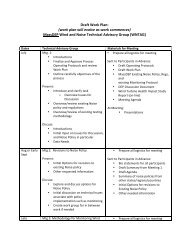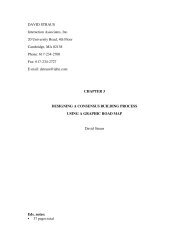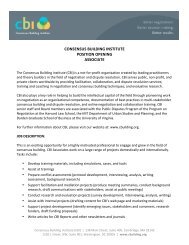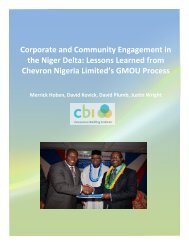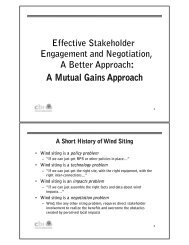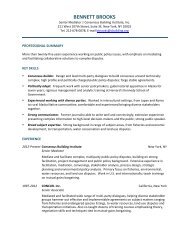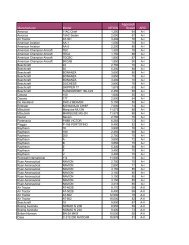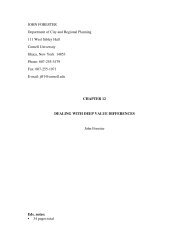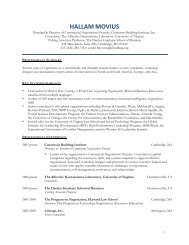Kristen Ferry DMF Presentation
Kristen Ferry DMF Presentation
Kristen Ferry DMF Presentation
Create successful ePaper yourself
Turn your PDF publications into a flip-book with our unique Google optimized e-Paper software.
Marine Fish Resources of the Neponset River<br />
T.Watts 2004<br />
<strong>Kristen</strong> H. <strong>Ferry</strong>
Important Marine Fish of the Neponset River<br />
Historic/Current<br />
River herring<br />
American shad<br />
J. Fascendola<br />
Rainbow Smelt
River Herring<br />
Actually, two closely related species…<br />
Bigger!<br />
alewife<br />
Alosa pseudoharengus<br />
Less common in MA<br />
blueback herring<br />
Alosa aestivalis
River Herring<br />
Actually, two closely related species…<br />
alewife<br />
Alosa pseudoharengus<br />
Managed together<br />
•Traditional bait fishery<br />
•Some consumption, roe<br />
blueback herring<br />
Alosa aestivalis
Ocean<br />
Anadromous<br />
River<br />
Headwaters<br />
Spawn in freshwater<br />
Majority of life--growth<br />
Estuary
Anadromous: River Herring<br />
Annual Spawning Migration<br />
SPRING<br />
Ocean<br />
3+ years<br />
Estuary<br />
River<br />
Headwaters<br />
SUMMER & FALL
American shad<br />
Alosa sapidissima<br />
•Largest member of the herring family<br />
•Inhabit/Inhabited larger coastal rivers<br />
(MA: Connecticut, Merrimack, Neponset, and Charles.<br />
Also Palmer and Indianhead)<br />
•Popular sport fish/consumption
Rainbow Smelt<br />
Osmerus mordax<br />
MarineFisheries restoration program<br />
•Smaller bodied with large teeth<br />
•Nearshore species, Canada to MA<br />
•Spawn only at night<br />
•Prized for taste<br />
•Neponset, one of few remaining<br />
healthy spawning populations
Anadromous: Where and When?<br />
Adults return to natal river to spawn…<br />
river herring<br />
April-June<br />
Ocean<br />
Estuary<br />
River<br />
Headwaters<br />
Smelt<br />
(above head of tide)<br />
March-May<br />
American shad<br />
May-July
So What?
Why Are Anadromous Fish Important?<br />
Ecological<br />
1. Provide food for other fish and sea birds<br />
2. Important source of oceanic nutrients for rivers<br />
Ocean<br />
Estuary<br />
River
Why Are Anadromous Fish Important?<br />
Ecological<br />
1. Provide food for other fish and sea birds<br />
2. Important source of oceanic nutrients for rivers<br />
Social<br />
•Historically important commercial & recreational<br />
fisheries<br />
•Consumption<br />
•Aesthetics—sign of spring &<br />
healthy river
A look at History and the Neponset…<br />
1623—Plymouth Colony Fish Law, protects alewife<br />
1709—Act passed to prevent obstructions to fish passage<br />
in rivers<br />
1741—Act passed requiring dam owners to provide<br />
upstream passage<br />
1797—
1797 and the Neponset…<br />
•Fishery established<br />
•Herring Committee appointed<br />
•Fish passage provisions<br />
•Herring warden appointed<br />
•Public sale of herring
A look at History and the Neponset…<br />
1623—Plymouth Colony Fish Law, protects alewife<br />
1709—Act passed to prevent obstructions to fish passage<br />
in rivers<br />
1741—Act passed requiring dam owners to provide<br />
upstream passage<br />
1797—Fishery Established<br />
1900s(early)—Neponset River highly polluted with sewage &<br />
industrial waste<br />
1972—Passage of the Clean Water Act – water quality<br />
improves<br />
No herring fishery!
Historic River Herring Abundance in<br />
Massachusetts<br />
First Fishway 1620<br />
Ca. 200 runs<br />
9 runs in Mass Bay<br />
(Belding 1920)<br />
100 runs<br />
100<br />
80<br />
60<br />
40<br />
20<br />
0<br />
1600 1700 1800 1900 1920 1950 2003<br />
Colonial Dams<br />
Industrial<br />
Revolution<br />
<strong>DMF</strong> fishway projects
Status of River Herring in MA<br />
Atlantic coast wide decline
Same scenario for American shad and smelt…
Why?
No access = No Reproduction!<br />
Ocean<br />
Estuary<br />
Dam<br />
Headwaters<br />
River<br />
Obstructions or dams continue to play a major role in the<br />
demise of river herring, American shad, and rainbow<br />
smelt populations….no access to spawning grounds
Typical Massachusetts Dams
In Coastal MA Rivers…<br />
380 Obstructions<br />
175 Fishways
With so many dams, why the Neponset?<br />
Because of its size and potential available spawning habitat,<br />
the Neponset could contribute more to resource recovery<br />
than any other system in MA.<br />
Fish passage in the Neponset<br />
is the highest priority for MarineFisheries
Options for the Neponset<br />
My perspective!
Dam Removal<br />
Ecological benefits<br />
•Improved water quality<br />
•Reduced sedimentation<br />
Full fish passage<br />
System functionality<br />
Merrimack Village Dam, Souhegan River, NH, August 2008 (M. Wamser)<br />
Partial dam removal can also be beneficial,<br />
if properly designed.<br />
Passage:
Dam Removal<br />
Billington Street Dam<br />
Town Brook, Plymouth<br />
>90% passage<br />
(Haro & Franklin)<br />
Species present:
Fishway: Denil<br />
Spill<br />
Entrance<br />
Attraction Flow<br />
Baffles cause<br />
turbulence & reduce<br />
velocity<br />
Ipswich Mills Dam, Ipswich River
Fishway: Denil<br />
•For shad, must be 4 ft. wide—BIG!<br />
•Baffle and cement maintenance<br />
•Usually has “trash rack”:<br />
requires regular debris removal<br />
•Requires board adjustment<br />
often in spring<br />
Newton Lower Falls, Charles River<br />
Passage:
Fishway: Rock Ramp<br />
•Eliminates current smelt<br />
spawning habitat<br />
•Prone to blowouts/<br />
maintenance<br />
For Neponset:<br />
4,000 lb main stones<br />
Increased elevation<br />
Long, slope<br />
Passage:
Fishway: Vertical slot & mechanical lift<br />
What will pass shad….<br />
(Typically installed at hydropower dams)<br />
BIG & N/A!<br />
Pawtucket Dam, Merrimack, Lowell<br />
Shad can still be finicky and refuse to use.<br />
Essex Dam, Merrimack, Lawrence<br />
Passage:
Restoration is Possible!<br />
Charles River, American Shad Restoration<br />
Hatchery origin juvenile<br />
Charles River, 2007
My perspective!<br />
Summary<br />
Options for the Neponset<br />
Dam Removal<br />
Most beneficial to fish resources and ecosystem function<br />
No maintenance for fish passage<br />
Fishways…A number of tradeoffs<br />
Less beneficial to resource sustainability<br />
Active rainbow smelt spawning habitat protection<br />
Shad are picky, picky, picky<br />
Much structure for less passage<br />
Routine maintenance throughout spring is required<br />
Long term maintenance substantial (also the dam)<br />
Expensive & untried design due to flooding issue
Thank you!
Fishway: Alaskan Steeppass<br />
Aluminum<br />
Plymouth<br />
Kingston<br />
•Inexpensive, smaller systems<br />
•The jury is out on passage….<br />
Passage:
Fishway: Pool and Weir<br />
This won’t work,<br />
river herring only
Major Improvement<br />
Foundry Pond Dam, Weir River, Hingham<br />
RH<br />
RH<br />
Done!<br />
smelt<br />
Goals: smelt habitat restoration; fishway repairs;<br />
water management; herring habitat and<br />
outmigration assessment (<strong>DMF</strong> & Contract)
New Passage<br />
Lynn Waterways Dam, Saugus River<br />
Partners<br />
•Lynn Water and Sewer Commission<br />
•Saugus River Watershed Council<br />
•GOM Council/NOAA Restoration Partnership<br />
Goal: Installation of custom ramp to create<br />
passage for American eels (<strong>DMF</strong>)
Feasibility<br />
Fore River System, Braintree<br />
?<br />
Partners<br />
•City of Braintree<br />
•Fore River Watershed Association<br />
•FX Messina Enterprises<br />
Goal: evaluate feasibility of restoring river herring to<br />
Fore River--passage, habitat, etc. (<strong>DMF</strong> & Contract)
Research<br />
Remote Digital Video Monitoring of River Herring<br />
Martha Mather & Jack Finn<br />
Massachusetts Cooperative Fish & Wildlife<br />
Research Unit, USGS-BRD<br />
UMass-Amherst<br />
Goal: Inexpensive, accurate technology<br />
to assess passage & runs
Massachusetts General Laws<br />
Chapter 130. Marine Fish and Fisheries<br />
Section 19: Providing passage for salt water fish into fresh water to spawn;<br />
refusal or neglect to repair or construct fishway; operation and maintenance<br />
of fishways





